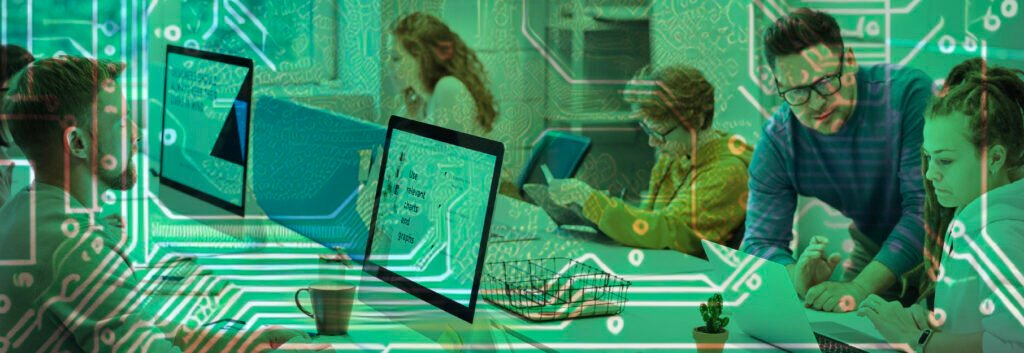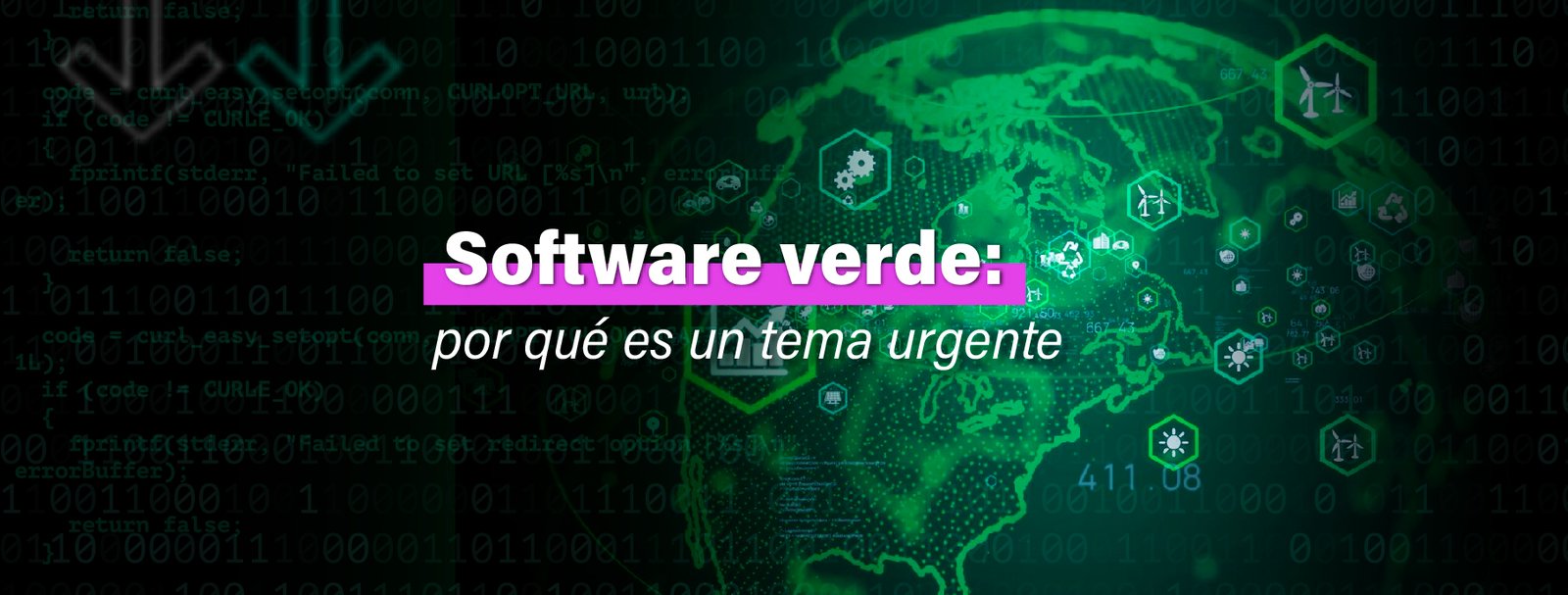Green software: what is it and what are its differential advantages?
The concept of sustainable software (green software) refers to computer systems and applications that are developed, implemented and used with the idea that their impact on the environment is minimal and their social impact is high.
Technology that promotes sustainability starts with an awareness of the place it occupies, and of the local, regional and global context. It also understands that it is time to regenerate the system and be part of a new way of doing business.
In this article, we break down the concept of sustainable software, its implications, and how it brings value to organizations. In addition, we evaluate the positive impact of the lean methodology in the development of sustainable systems.
What does it mean to be sustainable in the current context?
The commitment lies in embed sustainability at the heart of the business.
How is this done? Through the promotion of good social, environmental and economic practices. Also, through the implementation of concrete and innovative actions that generate a positive impact on the community and our environment.
At this point it is important to highlight that economic development must occur with people and not at their expense; with the environment and not at the expense of its balance.
A mindset with this orientation encourages teams to work collaboratively with the sustainable vision of organizations, and base their actions on values and a spirit of solidarity.
It is also essential to focus on inclusion and on generating more and better opportunities for personal and professional development in the community.
To do this, it is important that we perceive ourselves as agents of change, capable of contributing to the construction of a more responsible, fair and integrated society, based on the co-creation of solutions.
Within this framework, it is also necessary to promote alliances with partners who have a similar vision, in order to achieve sustainable objectives and increase the positive impact.
10 principles for technological sustainability
At IT Patagonia, we have been clear for years that We are not indifferent to the way we do business.
The Ten principles that define our purpose They aim to promote the sustainable development of current and future generations, in the technology industry, the country and the world:
- Support, respect, not violate and guarantee human rights.
- Collaborate in building a society free from discrimination, completely diverse and inclusive.
- Promote education and help reduce the gap in access to vocational training.
- To enhance and increase opportunities for access to a first quality and sustainable job, providing technological tools that guarantee inclusion in an increasingly competitive world.
- Generate social awareness and work collaboratively with our stakeholders to achieve a more responsible, fair and integrated society.
- Collaborate in reducing the gender gap that our industry currently suffers, promoting the empowerment of women and their leadership.
- Develop good practices that promote the care of the environment and natural resources.
- Generate a business culture, putting people at the center and working, every day, on their human and professional development.
- Cultivate ethical business and transparent corporate governance.
- Promote strategic alliances that help us co-create solutions that have a positive impact on the community and/or the environment.

Aspects to consider for sustainable software development
Taking into account the 10 principles of sustainability and its triple impact, we share some factors to take into account when developing green software.
Environmental perspective
Energy efficiency: the goal is to develop software that consume less computing resources and energy.
It is achieved through the implementation of agile and innovative methodologies for the development of projects, such as lean methodology, focused on waste elimination and operational optimization.
Other strategies include code optimization, the use of efficient algorithms, and the implementation of sustainable programming practices.
Sustainable design: involves considering sustainable design principles in the development of user interfaces and user experiences, to minimize the amount of energy and resources needed to use the software.
Data management: contemplates the implementation of efficient data management practices to reduce unnecessary storage of information and minimize the consumption of storage and processing resources.
Use of resources: involves encouraging responsible use of computing resources, such as servers and user devices, and promoting conscious technology consumption practices.
Full life cycle: in which the environmental impact of the entire software life cycle is evaluated, involving practices to minimize said impact at all stages.
Social perspective
Professional development: promotes the generation of technological training opportunities, with a focus on the generation of quality and sustainable jobs for people.
Convinced of this, in IT Patagonia:
- We invest in training scholarships together with our partner Codeki, so that more and more people can access quality technological education and start a career in the IT world.
- We awarded more than 1,500 training grants (21% of them to women), with more than 400 jobs obtained (34% of women), 250 of which corresponded to first work experiences (31% of women).
- We mentor over 400 people.
Through these actions, we are confident that we are creating a new digital mindset with the aim of creating the knowledge-based jobs that our country and the world need.
Solidarity: focuses on seeking to generate a positive impact on people, helping them channel their social vocation and increasing their commitment to community development and care for the planet.
Inclusion: The ability to build diverse teams and implement concrete practices linked to labor equity is another central aspect to consider when we refer to sustainable software development.
Advantages of implementing sustainable software
Implementing sustainable software development processes not only benefits the environment and the social environment.
It can also generate financial savings, help comply with regulations, improve corporate reputation and offer a competitive advantage in the marketplace.

Its advantages include:
- Reducing environmental impact: By optimizing the use of resources such as energy, it helps reduce the environmental footprint of a company's operations, contributing to the conservation of the environment and natural resources.
- Long-term cost savings: Reducing the consumption of energy and other resources allows for significant savings in operating costs over time.
- Regulatory compliance: The sustainability approach facilitates the correct observance of increasingly strict environmental regulations, avoiding sanctions and fines.
- Improving corporate reputation: Companies that demonstrate environmental and social responsibility through the development and implementation of sustainable software can improve their brand image and reputation among customers, investors, business partners and the community at large.
- Competitive differentiation:Green software can be a key differentiator in an increasingly environmentally conscious marketplace, allowing companies to stand out from the competition and attract customers and business partners who value sustainability.
- Strengthen your employer brand: By adopting environmentally responsible practices, such as reducing carbon emissions, using resources efficiently and promoting equality and diversity in the workplace, companies become Attractive employers for conscious and committed professionals.
These policies reinforce the company's identity as a place where employees can contribute to a larger purpose and work in an ecosystem that values the well-being of people and the planet.
As a result, the company can attract and retain high-quality talent, thereby strengthening its reputation as a top-tier employer brand.
Lean methodology and sustainable development
The relationship between lean methodology and sustainable software development lies in their shared focus on achieving efficiency and eliminating waste.
Some common practices include:
- Process optimization to eliminate activities that do not add value.
- Efficient use of resources such as energy and materials.
- Commit to continuous improvement, to increase efficiency and reduce waste at every stage of the development lifecycle.
Both approaches promote collaboration between teams, transparency, and accountability, which can result in more efficient, sustainable, and resilient software products in the long term.
Our methodology for developing green software
At IT Patagonia we implement in the projects from our software factories a development methodology inspired by the lean method, with which we manage to focus on eliminate everything that could be waste and cause loss of time or require rework.
From the start of a project, our specialists analyze client requirements from start to finish to anticipate waste that can be avoided, and then determine what is the most optimal process that we can propose.
During the analysis of the requirements and at the time of surveying them, we look for a way to have a Communication as fluid as possible with the stakeholder and the teams.
This stage is essential to ensure that everyone shares the same idea, to ensure that we are all understanding the same thing and to avoid reworking due to misinterpretations.
Based on the learning we obtain in each project, we improve our work methodology, which allows us to minimize work times.
It involves, for example, not only thinking from the functionality itself, but also involving the different flows, their interaction within the system and the design, to analyze the functionality and its scalability over time.
For example, we project scalability end to end, from features to design. This forward-looking approach allows us to have the least amount of waste and development hours when implementing new features or things, ensuring that in this way the carbon footprint that impacts the environment is reduced.
This is a methodology that does not have a monetary impact on the client, because it is part of IT Patagonia's regular practice.
This point is important, since the most costly thing that can occur in a software development project is the loss of time:
- Developmental
- Research and analysis
- By design (which may have to do with refactoring functionalities that were not previously analyzed or planned, and not stopping to think about the potential impacts that they could have based on what is new that is added when scaling a project).
Although this methodology takes time, it is a win-win: for the customer, who finds what he is looking for, and for the end users, who interact with products that respond to their needs, objectives and limitations.
Conclusion
For software development to be sustainable, it is necessary that it be designed from the outset with this approach, which covers environmental, social and economic aspects, as we explain in this article.
Our commitment to sustainability is directly related to the responsibility we assume when certify ourselves as a B Company, which allows us to meet strict verified standards of social and environmental performance, transparency and responsibility.
Our commitment is to continuous improvement, placing our socio-environmental business purpose at the heart of our business model.
As a B company We measure our social and environmental impact, and we commit ourselves personally, institutionally and legally to making decisions that consider the long-term consequences of our actions on the community and the ecosystem.
Likewise, we take responsibility and pride in belonging to a global movement of companies that want to make a change.
Are you interested in finding out how to boost your evolution through technological solutions with a positive impact? Contact us to arrange a meeting with our specialists.

